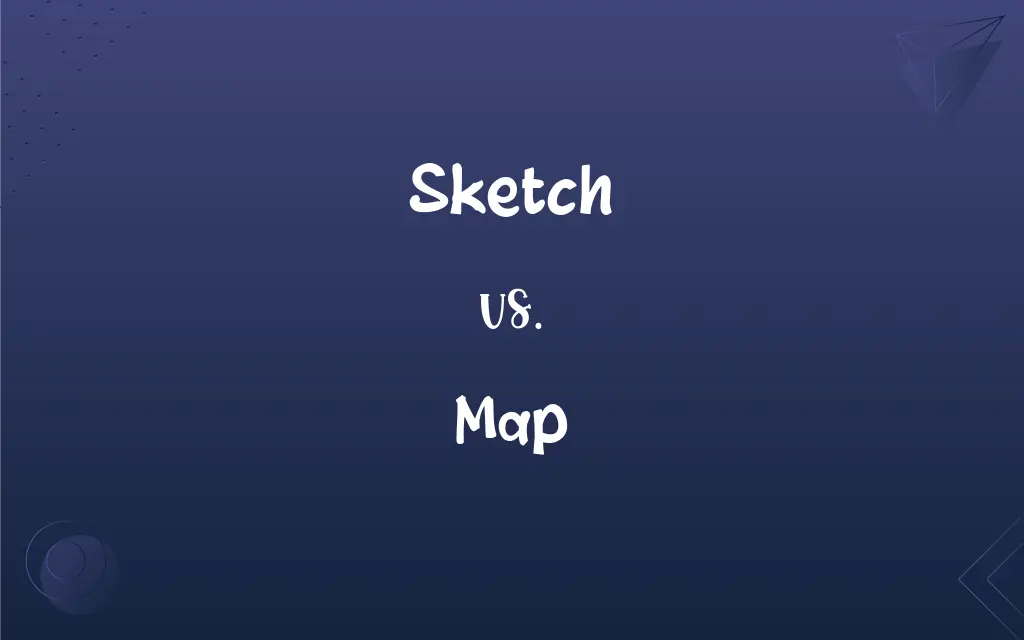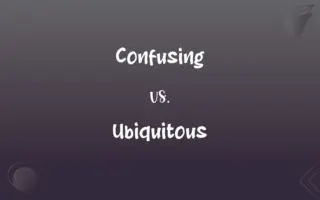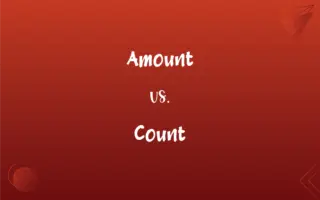Sketch vs. Map: What's the Difference?
Edited by Janet White || By Harlon Moss || Updated on November 3, 2023
A sketch is a rough or unfinished drawing, often made quickly, while a map is a detailed representation of geographic areas.

Key Differences
A sketch is often characterized by its lack of detail, intended to rapidly convey the basic elements or layout of a subject. It's used in various contexts from art to engineering. A map, in contrast, is a detailed representation, usually of geographic locations, and it's crafted to convey precise information about the area it represents, including dimensions, distances, and directions.
Artists create sketches to capture the essence of a scene or idea with swift, often imprecise strokes. Maps, on the other hand, are the domain of cartographers who require accuracy and specificity to ensure they are useful for navigation or planning. While a sketch might capture a moment or serve as a preliminary draft, a map is a finished product that has gone through a process of careful design and validation.
In a sketch, the focus is on the general shape or form, without an emphasis on scale or proportion. A map’s effectiveness, however, hinges on its scale and accuracy, providing a top-down view where every element is positioned according to strict standards. A sketch might be subjective, capturing the artist's perspective or intention, whereas a map is objective, presenting a location as it is.
Sketches serve as a means of visualization, helping in the conceptual stages of a design process or in the arts to quickly jot down ideas. Maps are tools of utility, guiding exploration, construction, and travel. A sketch may evolve into a more detailed drawing or serve as a reference, but a map is typically the endpoint of data gathering and geographic representation.
A sketch can be metaphorical, used in phrases like "a sketch of a plan," implying something is not fully formed. Maps are rarely used metaphorically; they are practical and concrete, designed to offer guidance. "Mapping out a plan" might be a metaphorical use, but it borrows from the map's inherent properties of direction and clarity.
ADVERTISEMENT
Comparison Chart
Purpose
To quickly capture or outline ideas
To represent geographic areas with precision
Detail Level
Usually rough and imprecise
Detailed and accurate
Focus
Form and general impression
Scale, orientation, and topography
Use in Design
Preliminary, conceptual stages
Finalized, practical application
Metaphorical Use
Common ("sketch of an idea")
Less common, but used ("mapping out a plan")
ADVERTISEMENT
Sketch and Map Definitions
Sketch
An initial version.
The architect’s sketch showed the potential of the design.
Map
To plan out.
She mapped out her career path.
Sketch
To draw informally.
He likes to sketch in his free time.
Map
A representation of an area.
We used a map to navigate the city.
Sketch
A rough drawing.
She made a quick sketch of the street scene.
Map
A diagrammatic representation.
The scientist created a map of the gene sequences.
Sketch
A brief outline.
The writer presented a sketch of the novel's plot.
Map
A guide for travel.
A subway map helps commuters find their way.
Sketch
A short performance.
They performed a comedy sketch.
Map
To associate closely.
The symptoms map onto the diagnosis.
Sketch
A hasty or undetailed drawing or painting often made as a preliminary study.
Map
A representation, usually on a plane surface, of a region of the earth, intended primarily to provide information about the relative location or nature of features within that region.
Sketch
A brief general account or presentation; an outline.
FAQs
Is sketching a talent or a skill?
Sketching can be both a natural talent and a skill developed through practice.
Are maps always geographic?
While maps are typically geographic, they can also represent other spaces like the human genome.
Can a sketch become a map?
A sketch can serve as a preliminary step before creating a detailed map.
Is it possible to sketch a map?
Yes, one can sketch a map, but it would lack the precision of a formal map.
Do maps include symbolic representations?
Yes, maps use symbols to represent various physical features or data points.
What is a quick sketch called?
A quick sketch is often called a doodle or a rough.
What is the purpose of a map's compass rose?
A compass rose indicates the cardinal directions on a map.
What is a topographic map?
A topographic map shows elevation and terrain using contour lines.
Can a sketch show accurate dimensions?
Sketches generally do not show accurate dimensions; they are more conceptual.
Do maps need a key or legend?
Most maps have a key or legend for understanding symbols and scales.
Can maps be interactive?
Yes, digital maps can be interactive, allowing for user engagement.
Are all maps drawn to scale?
For a map to be useful, it typically needs to be drawn to scale.
Are sketches used in police work?
Police use sketches to visualize suspects based on eyewitness descriptions.
Can a sketch be detailed?
Sketches can have detail but are generally less detailed than final drawings.
Are maps considered art?
Some maps, especially historical ones, are considered art due to their aesthetic qualities.
How important is shading in a sketch?
Shading in a sketch can add depth and dimension, but it's not always necessary.
Do maps only represent physical features?
Maps can represent various types of information, including demographic or statistical data.
What tools are used for sketching?
Common tools include pencils, pens, charcoal, or digital drawing devices.
Do architects use sketches?
Yes, architects often start with sketches to conceptualize designs.
Can a map be outdated?
Yes, maps can become outdated as landscapes and political boundaries change.
About Author
Written by
Harlon MossHarlon is a seasoned quality moderator and accomplished content writer for Difference Wiki. An alumnus of the prestigious University of California, he earned his degree in Computer Science. Leveraging his academic background, Harlon brings a meticulous and informed perspective to his work, ensuring content accuracy and excellence.
Edited by
Janet WhiteJanet White has been an esteemed writer and blogger for Difference Wiki. Holding a Master's degree in Science and Medical Journalism from the prestigious Boston University, she has consistently demonstrated her expertise and passion for her field. When she's not immersed in her work, Janet relishes her time exercising, delving into a good book, and cherishing moments with friends and family.































































